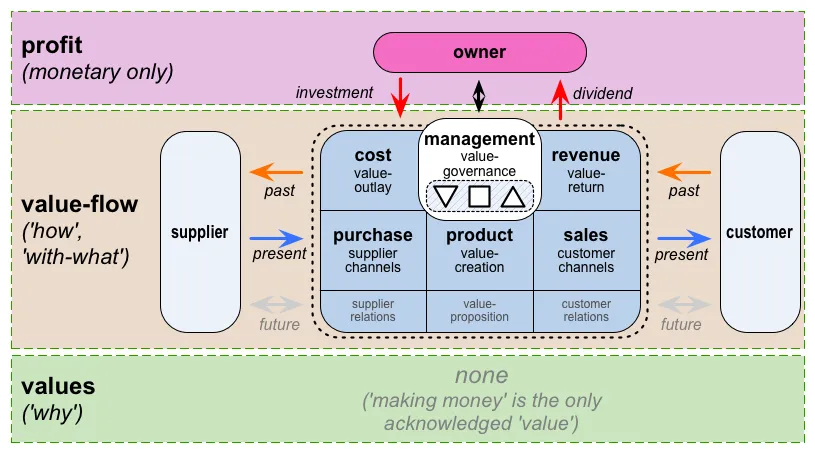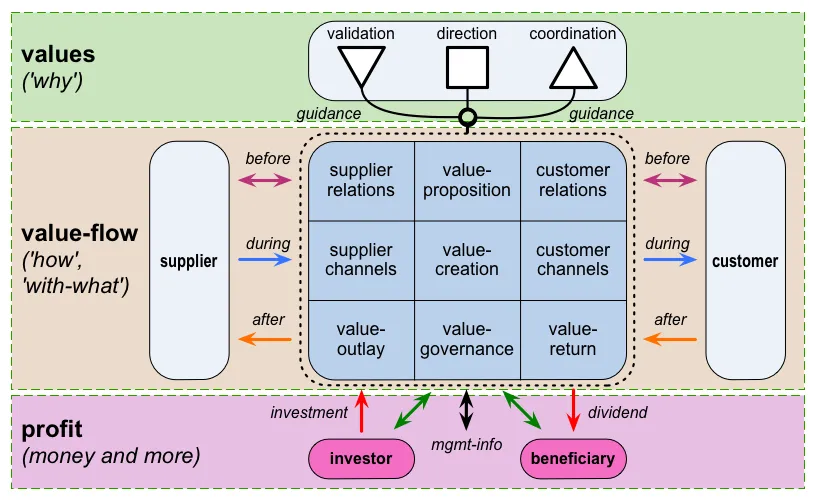Enterprise-architecture – a further-futures report
Blog: Tom Graves / Tetradian
We’ve explored the current status for enterprise-architecture [EA]; we’ve explored the changes to the discipline over the past few decades. Time now, perhaps, to assess the future – or futures, rather – of its likely onward development and direction.
This report is in two parts:
- 1: Near-future – 1-10 years
- 2: Further-future: 10-50 years (this post)
First, though, a quick summary of key principles on the focus and role of enterprise-architecture:
- core theme is that things work better when they work together, on purpose
- we develop an architecture for an organisation, but about the shared-enterprise(s) of that organisation’s context
- architecture-work may apply to any scope, any scale, any content, any context
- we provide a balance and bridge between structure and story
As a discipline, EA is a generic toolkit for integration, connection, relations, across an entire context, with fully-fractal assumptions, definitions, tools, frameworks and methods, drawing on key skills such as complex problem solving, critical thinking and creativity.
What EA brings to the party is that emphasis on connection – on getting things to work better, together, and ‘on purpose’. As such, it’s probably the only discipline that can or will bridge everywhere across an entire enterprise, across all stakeholders at every level, from strategy to execution and back again:

Crucially, the architect’s role is about decision-support, not decision-making. The architect brings clarity on what the choices are, and why – yet the final choice always resides with the client, not the architect. The further we expand the scope and scale of architecture, the more important those points become…
And architecture is fractal. Over the past few decades we’ve learnt how to do architectures not just at project-scale and department-scale, but whole-organisation scale as well. And in the previous part of this report, we explored some of the types of work that is already being done in ‘big-picture enterprise-architecture’, not just beyond IT, but beyond the boundaries of an organisation too, finding better ways to balance ‘inside-out’ and ‘outside-in’.
Yet if architecture is fractal, then there’s no reason why we should stop at that scope and scale. And there are plenty of urgent reasons now why we can – and should – continue onward from there. So this part of the ‘EA-futures report’ is likewise a direct logical progression from the same methods and suchlike, but at an even broader scope and scale – in other words, ‘really-big-picture enterprise-architecture‘ [RBPEA].
(I’d guess that a fair few people may find this post not not so much controversial as laughable. Yet before you laugh too loud, remember my track-record here? – a decade ago, most people in ‘the trade’ still mocked me for suggesting that EA should be about more than just IT-infrastructure…)
Okay, right now there are perhaps only a handful of people worldwide who are working out there in the RBPEA space. But to me it is the future of EA, and it is already happening. Or at the very least, some of the fault-lines that will drive whole-of-society-scale change over the next half-century or so are already out in the open, ‘hidden in plain sight’, and the architectural approaches with which we’d need to address them are becoming more clear as well.
For example, consider sustainability. Although the concept has many different connotations, one key international definition is that:
[sustainability is] meeting the needs of the present without compromising the ability of future generations to meet their own needs
The blunt reality is that, in global terms, we’re not doing well on that one…
More worryingly, we’re not even doing well on how to train and organise the new kinds of work that we’d need in order to do well on that one. For example, to quote from a World Economic Forum study:
our educational system is not adequately preparing us for work of the future
At a societal scale, we don’t even know how to support the people doing that kind of work:
just because a profession is producing something desirable, or even necessary to the functioning of society, doesn’t mean society has figured out a way to pay for the care and feeding of its practitioners
And, to make it even worse:
our political and economic institutions are poorly equipped to handle these hard choices
On the surface, there’s perhaps not much we can do about these themes right now – to be blunt, most of our ‘world’ isn’t ready for that as yet. But even now, we can at least look, and then think carefully about the architectural implications at that same very large scale – so that when the time comes, we are ready to take appropriate action, and fast.
In the nearer future – up to around 20 years from now – probably the main focus will need to be around the skills-challenges, as above, and also doing much more towards implementing a circular-economy model, in manufacturing and preferably more. None of this is actually new: many traditional cultures have been doing this as deliberate practice for millennia, and even in the industrial context there are well-established exemplars such Ray Anderson’s ‘Mission Zero’ at Interface Inc. Ideas such as sustainable-design, eco-design and Nicholas Nassim Taleb’s antifragility could also play a key part in providing principles to guide whole-enterprise architectures in this broader space.
But beyond the 20-year mark – or, increasingly, for RBPEA work anywhere from 10 to 50 years from now? – well, that’s where things are going to get messy…
Back about twenty years ago I coined the concept of a mythquake – the societal equivalent of an earthquake, in which the tectonic plates of the soul and the broader society come into collision with Reality Department. Perhaps the simplest way to describe the core drivers behind this is Richard Feynman’s blunt warning, in the last sentence of his addendum to the Rogers Report on the Challenger disaster:
For a successful technology, reality must take precedence over public relations, for nature cannot be fooled.
In short, a mythquake occurs whenever there’s a mismatch between expectation and reality – and reality always wins in the end. The severity of a mythquake rises steeply with the level of self-delusion – hence, for example, as Feynman also warns in his Rogers Commission addendum:
When playing Russian roulette the fact that the first shot got off safely is little comfort for the next.
In my work on mythquakes, I mapped out a basic severity-scale, from MQ-1 to MQ9, roughly paralleling the physical-world Richter and Mercalli scales for earthquake energy and impact respectively. An MQ-1 mythquake is something we’re all likely to experience many times a day – trivial in real-world terms, though it may not feel like it at the time! – whilst an MQ-3 is the level we and those around us might feel at the loss of identity on losing or moving on from a previous job. An MQ-5 mythquake is what we’d expect to see now with any major financial-crash, such as that in 2008 – large-scale impacts, all the way up to global scale.
Mythquakes at MQ-6 and upward are fortunately rare, but their impacts are correspondingly huge – which is perhaps most people avoid talking about them at all. When I wrote about RBPEA implications of the MQ-7 level societal messes around gender, what I got back was mostly a thunderous silence, with a few accusations of ‘misogyny’ and suchlike thrown into the mix – which completely missed the point, of course. And much the same – though perhaps with an even more thunderous-silence – when I wrote about MQ-8 level delusions about ‘rights’ and the like, and on to the MQ-9 level disasters-waiting-to-happen lurking beneath the many myths and sensemaking-sins about possession. The blunt reality, though, is that when faced with major mythquakes, wilful-ignorance is not a survival-strategy – yet that’s about all that most people seem to be doing about this right now…
Which is why, to me at least, this is a genuine and urgent role for enterprise-architects – because we’re one of the very few disciplines that has appropriate skillsets right now to apply to these lethally-real concerns.
(That they are indeed urgent concerns now should not be in doubt. For example, our current economics not only assumes but requires the existence of infinite-growth – yet even the most basic logic indicates that we cannot have infinite-growth on a finite-planet. It’s already been more than forty years since the ‘The Limits to Growth‘ study showed that even back then we were already hitting up against non-negotiable barriers and constraints at a global scale – and we’ve gone a long way further down the path towards non-survivability since then. Oops…)
So, first, some practical realities:
- the money-system can ‘grow’ to infinity, but the real-world can’t – so we cannot have an infinite money-system that assigns itself ‘rights’ to definitely finite resources
- the money-system itself introduces many lethally-destructive distortions - so we have to find a way to run an economy without money or any other form of ‘metacurrency’
- the concept of ‘rights’ is a literally-lethal dead-end – so we have to find a way to restructure the entirety of our social and economic systems beyond any concept of ‘rights’
- every item or resource we dig up and throw away is something that, in effect, we’re stealing from the future – so any form of planned-obsolescence needs to be understood as a crime against the future
- much of our justice-systems depend on possession-based threats such as confiscation and monetary ‘fines’ – so we need to redesign our justice-systems in ways that do not depend on any form of possessionism
And yes, that’s definitely non-trivial…
Yet in reality most of the underlying principles for what to do about all of this are very simple indeed. For example:
- Bob Marshall‘s ‘antimatter-principle‘, of “attend to folks’ needs”
- reframe all law in terms of ‘principle-first’, not ‘rule-first’
- reframe power as ‘the ability to do work’, not ‘the ability to avoid work’…
- the only relationship that works is from responsibilities, not ‘rights’
- the only outcome that works is ‘win-win’ – everything else is an illusory form of ‘lose-lose’
- everything is interconnected – systems within systems within systems intersecting with other systems
The moment we move away from any of those principles, we create unneeded complexity, unnecessary fragility and, all too often, serious social-dysfunctions; but when we move towards those principles, we inherently reduce complexity, fragility and dysfunctionality. For example, consider what happens when we dump the delusion that the money-economy can ever be made to work:
- we break free from the parasitism that underpins the stock-exchange and suchlike
- we no longer describe a new development as ‘an opportunity to make money’, but as an opportunity for soul-engagement
- we can refocus attention on ‘low-profit’ but highly-important themes such as infrastructure
- we can end the fragmentation caused by privatisation of shared-resources such as tollways and the like
- we can provide support for all of societal needs – such as parenting and elder-care and and artistry and futures-work – rather than forcing all attention onto that lesser subset of skills and activities that ‘make money’ for someone else
In short, applying the principles properly means that we can break our organisations and economies free from the petty parasitism that underpins the present-day fetid swamp of top-down Taylorist disservices:

And turn them round into genuine services, each interdependent with each other, based on viable values-architectures, and in which management is merely ‘just another service‘, no different and no more important than anything else:

And yes, there are many other themes we might consider, even right now, such as:
- we need to refocus education to developing meta-skills and systems, and emphasise life-long learning
- we need to refocus technology in areas where it works best, in predictable or ‘order’-type contexts, and provide better support for humans doing ‘unorder’-type work
- we need to ensure that AI and similar technologies always remain human-comprehensible – not least because the reality of high-order kurtosis-risks such as a Carrington Event means that we need catastrophes to be survivable without the availability of advanced technologies
To illustrate this, and just as a thought-experiment, go down to your local town-centre or shopping-mall, take a look around, and then ask yourself questions such as these:
– What would a shopping-centre be like – be for – if its focus was not about pushing junk that no-one needs, but instead about supporting what people do need?
– What would be the purpose – if any – of banks, insurance, real-estate and many more, if the economy did not depend on money, and hence no need for money?
– What would happen to food-shops if the focus was no longer on pushing junk-food at ‘low prices’, but instead truly concerned about people’s health?
– What would clothes-shops be like if the focus shifted from creating artificial ‘wants’ for poor-quality overpriced tat, to clothing for life – a focus on wearability rather than disposability?
That’s what we’re really looking at here, as the real role for enterprise-architecture in the further-future.
To be blunt, what we live in right now is not so much an oligarchy, or a patriarchy, or even a kleptocracy, but a paediarchy – ‘rule by, for and on behalf of the childish’. In essence, our entire economics is built around the possessive temper-tantrum of a two-year-old – the incessant shrill cries of ‘Mine! All mine!’ and ‘Want it now!’. Kinda dispiriting, really. And the huge danger – the very real danger – that all of face right now is that that paediarchy is inherently incompatible with our long-term survival. Oops…
Yet as enterprise-architects, how do we create the support and structures needed for a shift from the present-day possession-based model, to a more viable responsibility-based model, when there are so many vested-interests in maintaining the dysfunctional systems and structures? Creating the conditions for that change is the professional challenge that we face right now – and for the next fifty years or more.
No doubt we’d love to keep all of those complexities out of our own EA-story, and to be able to wave around a sign like this:

But the blunt reality is that, whether we like it or not, enterprise-architecture will always be ‘relentlessly political‘. We need to face up to that fact – and face up to our responsibilities to take action now, towards a more survivable future.
I’ll leave it at that for now: over to you for comments, perhaps?